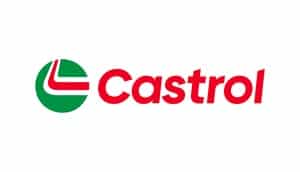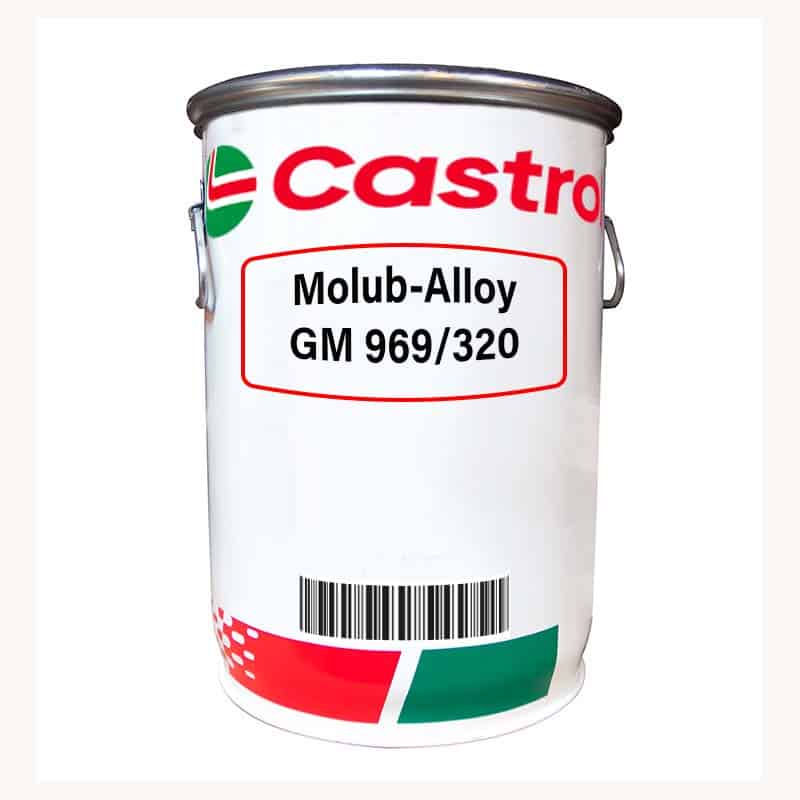Castrol Molub-Alloy GM 969/320


VISCOSITY - ISO 320
Castrol Molub-Alloy GM 969/320 Leak Resistant Gear Compound
Castrol Molub-Alloy GM 969/320 (previously called Molub-Alloy 969/320) Leak Resistant Gear Compounds are manufactured by adding a small amount of a synthetic thickener to standard ISO-grade gear oils.
The small addition has a moderate thickening effect on the oils, especially in the container, or while not in motion. During the stirring action of gears and bearings, however, 969 exhibits rapid flow and film-forming characteristics similar to the original base gear oils.
Molub-Alloy GM 969 Leak Resistant Gear Compounds were originally developed for service in heavy duty earth moving equipment such as shovels and draglines. Surging stress and vibration on these machines inevitably produce some degree of leakage from gear cases, excessive leakage at shaft seals is not uncommon on hoist, drag, propel, and especially swing gear cases of large draglines and swing cases of shovels.
Often the tramp oil will contaminate the heavy gear compounds necessary to lubricate the exposed open gear drives. The use of 969 Gear Compounds can also be extended to control leaks in gear sets in industrial and marine applications. Molub-Alloy GM 969 Leak Resistant Gear Compounds are specially formulated to help control leaks in gear cases.
The synthetic thickener forms a mat-like matrix at the points of leakage to minimise the flow of oil. Leakage from gear cases has traditionally been controlled by the substitution of a grease for the lubricating oil. This is unsatisfactory because greases can channel, and are poor at carrying heat away from the meshing gears and dissipating from the gear case.
The moderate thickening of Molub-Alloy GM 969 Leak Resistant Gear Compounds is not the characteristic that helps to control leaks at cracks and seals, it is the nature of the synthetic thickener to link or gel to bridge the opening with a restricting consistency. Other than this restricting action at small openings, Castrol Molub-Alloy GM 969 Leak Resistant Gear Compounds act very much like the original base gear oil in service.
Molub-Alloy 969 Leak Resistant Gear Compounds were developed using base oil viscosities of ISO standard grades.
Currently, we offer a leak-resistant gear oil with a base oil ISO viscosity grade of 320.
| Name | Method | Units | Molub-Alloy GM
969/320 |
| Consistency
|
– | – | Semi-Fluid |
| Appearance
|
Visual | – | Fibrous |
| Specific Gravity @ 60°C / 140°F | ASTM D1298 / ISO
3675
|
– | 0.9 |
| Apparent Viscosity, Brookfield @ 72ºF, Spindle 6,
20rpm
|
ASTM D2983 / ISO
9262
|
cP | 18,750 |
| Flash Point – open cup method | ASTM D92 / ISO
2592
|
°C/°F | 229 / 445 |
| Fire Point,
|
ASTM D 92 | ºC | 260 |
| Pour Point
|
ASTM D 97 | ºC | N/A |
| Four Ball Wear Test, Scar Diameter (40kg, 75°C/
167°F, 1800rpm, 1hr)
|
ASTM D2783 | mm | 0.45 |
| Four Ball Weld Load test – Load Wear Index | ASTM D2783 | kgf | 44 |
| Four Ball Weld Load test – Weld Point | ASTM D2783 | kgf | 400 |
| Antiwear test – Falex Pin & V-Block | ASTM D2670 | Teeth Wear
(number)
|
3 |
| Falex EP Test
|
– | psi | 1750 |
| Foam Tendency (a Tribol Test using a Waring Blender,
subjects lubricant to max shear for 5 mins), measures time to no foam
|
Tribol Test
|
– | No foaming |
| Oxidation Stability @ 95ºC, % viscosity increase
|
ASTM D 2893 | – | +2.25 |
| Molub-Alloy Solids Grade Classification
|
– | – | Fluid Lubricant |
| Base Oil Properties ISO Viscosity Grade
|
ASTM D 2422 | – | 320 |
| Base Oil AGMA Lubricant Number
|
– | – | 6EP |
| Base Oil Viscosity @ 100ºC
|
ASTM D 445, D
1261 |
cSt | 25 |
| Base Oil SAE Viscosity Classification
|
– | – | 140 |
| Base Oil Viscosity Index
|
– | – | 100 |
| Base Oil Pour Point | ASTM D97 / ISO
3016
|
°C/°F | –15 / +5 |
| Base Oil Rust Test , Procedures A and B
|
ASTM D 665 | – | Pass |
| Base Oil Copper Corrosion 3hrs @ 100ºC
|
ASTM D 130 | – | 1b |
| Base Oil FZG Test (A/166/140), Load Stages Passed
|
– | – | 12+ |
| Base Oil FZG Test (A/83/90) Load Stages Passed
|
– | – | 12+ |
| SRV (400N, 20ºC, Amplitude 1mm, 50Hz), coefficient of
friction
|
– | μ | 0.08 |
| Base Oil Timken EP Test (ASTM D 2782) OK Load | – | kg/lb | 32 / 70 |
Important Restrictions:
Molub-Alloy GM 969 Leak Resistant Gear Compounds are not for use in units that include a central lubricating system as they will not pump like oil or flow through small lines. 969 will plug filters.
GM 969 Leak Resistant Gear Compounds should not be used in gearcases where shaft bearings are lubricated by oil flowing through small lines or orifices as they will seal small openings or seriously restrict oil flow. On the other hand, where bearings are submerged, and oil flow is not unidirectional, flow is not restricted.
These compounds are designed for use in gearboxes where gear oil makeup volumes are unacceptable due to worn shaft seals or other minor causes of leakage. The 969 Compounds should be used as gearbox fill only until the repair of the leaking condition can be conveniently performed.
Castrol Molub-Alloy GM 969 Leak Resistant Gear Compounds are not designed to prevent leakage due to gross mechanical defects such as worn bearings and damage causing shafts to experience excessive play which results in excessive lubricant makeup.
Notes
Molub-Alloy GM 969 Leak Resistant Gear Compounds may be metered through grease pumping systems but would be expected to cavitate in oil circulating pumps.
Molub-Alloy GM 969 Leak Resistant Gear Compounds will flow readily when agitated but should not be expected to flow by gravity or feed through small lines. Molub-Alloy GM 969 Leak Resistant Gear Compounds must be stirred vigorously
before use.
Since filters must be removed when using Molub-Alloy GM 969 Leak Resistant Gear Compounds, routine oil sampling is strongly recommended.
This product was previously called Molub-Alloy 969/320. The name was changed in 2015.

Request a quote for this product
"*" indicates required fields